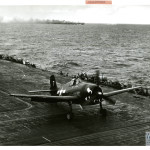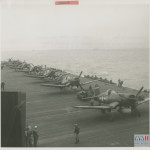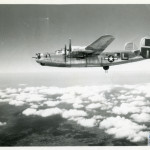SciTech Tuesday: Engine advancements drive airpower revolution
A good part of the development of aircraft in World War II was driven by advancements in the internal combustion engine in the two decades after World War I.
Engineers worked on plans and designs and working internal combustion engines throughout the 1800s, but that century was largely dominated by steam engines.
Steam engines use expanding water vapor to turn turbines, which were connected to mechanical devices to power trains, manufacturing machines, and other mechanical devices. Steam power is still used today in most electrical generating plants, which use nuclear power, coal, oil, or natural gas to make steam. Steam is also often used in large ships.
The internal combustion engine uses a controlled explosion in a chamber to create expanding gases, which move a piston in a cylinder. The first reliable internal combustion engines were designed by engineers (whose recognizable names included Diesel, Daimler, and Benz) in the 1880s. In the early 1900s automobiles became the focus of internal combustion engine development.
As the world powers on either side of the conflict began readying for World War II, pressure grew to devise engines powerful and light for aviation. The development of these engines took two basic paths—linear, liquid cooled engines like the Rolls Royce Merlin engine. Licensed to Packard, this engine powered the P-51 Mustang. The other path was air-cooled rotary engines.
Pratt & Whitney developed the Twin Wasp engine in 1930, and it powered the first trans-Pacific commercial flights when Pan American opened them in 1935. This engine had two rows of 7 cylinders each arranged in two rings. The first Twin Wasp had 800 hp, but later models had improvements that led to up to 1,200 hp. The Twin Wasp was used in the DC-3, its military counterpart the C-47 Skytrain, and the B-24 Liberator. Probably the most-produced large engine in history, about 173,000 Twin Wasps were made in the WWII era.
From the Twin Wasp Pratt & Whitney developed the Double Wasp, which had 18 cylinders and up to 2,400 hp. This engine was used in the F4U Corsair, the P-47 Thunderbolt, and the F6F Hellcat. During the war about 125,000 of these engines were produced.
To increase the power of an internal combustion engine, you can increase its displacement (the internal volume of the engine) by increasing the number of cylinders or the size of the cylinders. This is, for example, why you would expect more power from a car with an 8 cylinder 4.7 liter engine than one with a 4 cylinder 1.8 liter engine. Another way to increase the power from an engine is to more efficiently achieve combustion by coordinating the timing and volume of air (which contains the oxygen the explosion needs), fuel, and the spark which creates ignition.
Above 16,000 feet in altitude, air is thin enough that it is a challenge for internal combustion engines. Engineers matched this challenge by using technologies still used in internal combustion engines today—superchargers and turbosuperchargers.
Superchargers force air into the engine with a fan or turbine. A simple supercharger uses the engine to power the turbine by a belt or some other mechanism. A challenge for aviation supercharging is that a supercharger that works well at very high altitudes might blow out the engine by forcing in too much air at lower altitudes. Thus engineers used two-stage superchargers—a single supercharger to work all the time, and an additional one that the pilot switched on, or that automatically came on, at higher altitudes.
A turbocharger works similarly, but often more efficiently, by using exhaust to power a turbine. The supercharger takes some power away from the engine, while adding even more. A turbocharger works on waste energy and thus takes no power from the engine. Also, because the exhaust air is still expanding, it moves the turbine very effectively. A disadvantage of the turbocharger’s use in WWII aircraft were that it used a lot of tubing to capture exhaust and force air, and that the high temperatures of the exhaust on the turbine required special materials. There is also a lag between turbocharging effectiveness and need, since it uses exhaust.
Combinations of multistage supercharging and turbocharging were used in all American aircraft in WWII.
Jet and turboprop technology were under development during WWII. German aircraft using jet engines, and in mid-to-late 1944 British (Gloster Meteor) American (P-80) and German (eg. He 162, Me 262) planes were used. These planes were small in numbers and had limited impact on the war. The German V-1 also used a jet engine.
After the war jet and turboprop technology dominated military aircraft development.
Posted by Rob Wallace, STEM Education Coordinator at The National WWII Museum.
Images are from the collection of the National WWII Museum
- The Grumman F6F Hellcat used a Pratt & Whitney Double Wasp engine.
- A line of Vought F4U Corsairs rest on a carrier in the Pacific Ocean. The Corsair was powered by the Pratt and Whitney Double Wasp. There is a Corsair on exhibit in the U.S. Freedom Pavilion: Boeing Center at the NWWII Museum.
- A B-24 Liberator, with 4 Twin Wasp engines flies on a mission. The NWWII Museum has a B-24 fuselage and an isolated Twin Wasp Engine on exhibit in the U.S. Freedom Pavilion: Boeing Center.
- Posted :
- Post Category :
- Tags :
- Follow responses to this entry through the RSS 2.0 feed. You can skip to the end and leave a response. Pinging is currently not allowed.







Leave a Reply